|
|
|
|
|
|
|
|
|
|
|
|
|
|
|
|
|
|
|
|
|
|
|
Subsidiaries: |
|
|
|
|
|
H & O Revival |
|
|
|
|
|
|
|
|
|
RR Memorabilia: |
|
|
|
|
|
|
|
|
|
|
|
|
|
|
|
|
|
Utilities: |
|
|
|
|
E-mail

|
|
|
The H & O Revival Begins |
|
THE
Hilton & Ohio Division was designed to be a fictional route bridging the
small agricultural Village of Hilton with the five major railroads which
once served Rochester, N.Y. – the New York Central System, the Erie (later
Erie-Lackawanna) Railroad, the Baltimore & Ohio Railroad, the Lehigh Valley
Railroad and “The Standard Railroad of the World,” the famous Pennsylvania
RR. Equipment from all of these, as well as some of their predecessors and
successors, operate at the will of the management on the trackage of the
Hilton & Ohio and its parent, THE
NORMANED RAILROAD (see map area on H & O
Page 1). Thus, considered in combination, the NN&T system operates to and
from various locations within the States of New York, Ohio, Connecticut,
Pennsylvania, and the Province of Ontario, Canada. In a legacy from the
Connecticut heritage, the lines also reflect some interchange activity with
the New York, New Haven and Hartford Railroad. |
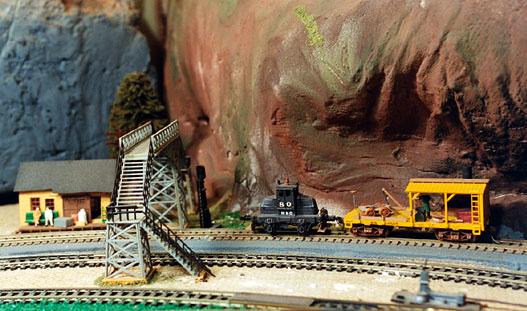
|
The H&O Division’s Mack Switcher (by Scale Structures, Ltd.) makes
its way slowly along a mountain range, with a Walthers blacksmith
car in tow, on the way to the company shops to assist in the
revived model railroad restoration program which began in 2002. A
pair of passengers wait with their baggage at a nearby freight
house for the next H&O mixed local – the first one scheduled in 18
years! (Click
here to see rolling stock detail) |
|
Until early
June of 2002, the Hilton & Ohio Division had been in virtual abandonment
since April of 1984 (more than 18 years), following
partial demolition as the result of a major windstorm and electrical
fire. In fact, earlier text on this web site states that “The H&O damage has
not been repaired.” But now, first insidiously and then serendipitously, the
revival is under way! |
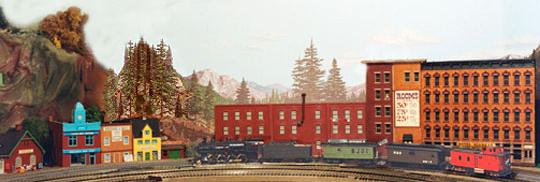
|
A
panoramic view of a train passing the municipal buildings and
headed into the nearby Rocky Ridge area on the "Hilton Module" of
THE NORMANED's H&O Division. |
Inspired by
a few drops of paint . . . .
|
|
|
The move
toward the start of the restoration all began as the result of a search in
the basement for some flat black paint. [In the course of painting the back
porch, a little light-colored house paint had spattered lightly in a couple
of spots on a black stair railing and I thought I might cover the “evidence”
with some old hobby paint which might be useable, even after aging in its
container during all the years following the railroad’s shutdown in the
1980s. I may have neglected the railroad for years, but I have a reputation
for never throwing anything away since “That might be just the thing I’m
looking for someday”].
I found some flat black, along with some glossy black, as well as some
blue, brown, green, yellow, gray, red, purple, white, silver, gold, copper,
tan, pink, maroon, many special railroad and weathering colors, etc. –
actually more than 100 bottles altogether, many in several various brands
and in assorted shades. About two out of every three of them were discovered
to be unspoiled, even though some could be identified as being more than 35
years old! Enamels, lacquers, acrylics and water colors were included.
|
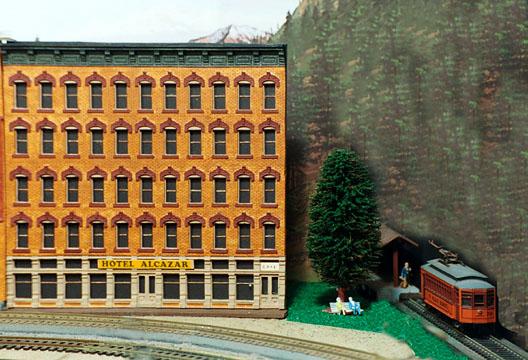
|
This is the aristocratic Hotel Alcazar, inspired by a similar
period place of lodging near Cleveland, Ohio. Note the main
entrance at the center and the Cafe doors at far right of the
ground floor. In the courtyard and shelter at the right of the
building, hotel guests may await and board the local streetcars. |
|
So I now had more than 70 paints to choose from
with all the bottles having been cleaned and all of the salvaged paint
inspected, stirred, thinned if necessary, and tested. Next question – where
to store it and for what reason? I found a suitable rack with several
shelves which would hold the cache of paint nicely, and the railroad room
would be the obvious place to keep the rack. But alas, all of the “railroad
rooms” were themselves so cluttered after the years of inactivity that like
the famous Jerusalem inn of two millennia ago, there was “no room for the
rack.” |
|
A search for a corner or wall area to clean up to
store the paint rack brought discovery of more forgotten treasures. Parts
cabinets with more than 400 of those little plastic parts drawers were
tucked away all over the place – most of them labeled or otherwise
identified, but lots of things in their original packaging, but which had
never been taken from their original brown paper bags and distributed to the
proper parts cabinets and drawers when the “Apathy of the Eighties” took
command.
As I had made an inventory/directory of all of these parts in early
1988, I began adding the new parts to the cabinet drawers and noting their
location for the purpose of updating the inventory “catalog.” Concurrent
with all this “organization,” of parts and paint, I had joined up with a
small group of local model railroaders to publish a newsletter to help liven
up and strengthen the hobby in the local area, and by this time I was
beginning to feel the magnetism drawing me back to the HO addiction. |
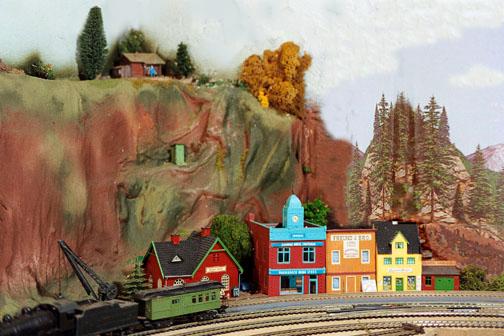
|
An accommodation train with a lone passenger-baggage combination
car pulls out of the tiny hamlet of Rocky Ridge on the H&O
Division. To the right of the station (l-r) are the drugstore and
publishing house, a gun shop, the general store and the small
County Morgue. For those who wish to climb to the cabin at the top
of the mountain, a "facility" is provided at the halfway point. |
|
|
|
In early July of 2002, Grandson Ben joined the H&O
“team” and the serious revival work was under way. We decided to begin with
the “Hilton Module,” where the first loop(s) of track -- described on H & O
Division Page 1 -- and considerable scenery had been built 18 years earlier.
First, we removed everything from this part of the layout which was
not fastened down, cleaned every inch of track, checked every track switch
(including a crossover on two adjacent sections of curved track) and tested
all of the electrical wiring, making repairs where necessary. Then we looked
over the locomotives which we had removed and performed necessary cleaning,
dusting, lubrication and testing. By the end of our first session, although
the layout was otherwise “bare bones,” we were able to keep three short
trains and a point-to-point trolley car running simultaneously, and every
single track switch worked perfectly, both electrically and mechanically.
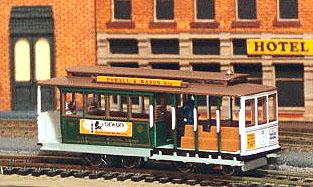 |
|
A
guided tour in an interurban car -- newly converted from a
replicated San Francisco-type cable car and retrofitted to run
without the cable -- awaits passengers at a brief hotel stop on the
H&O Division. The conductor will soon shout "All Aboa-a-a-a-rd!" |
|
Between the
first and second session, my wife Florence and I spent a considerable
number of hours on several days repairing scenery, including installation
of a new background, and restoring most all of the perimeter buildings.
The next session with Ben consisted in working toward completing track
ballast and adding ground cover where there had previously been none. The
module was now ready for some pictures of the progress, and we retained my
professional photographer brother, Don, who took most of the new photos in
this section. (The previous illustrations of views of the Hilton Module’s
interior remain in their original places on
the H&O Division Page 1).
|
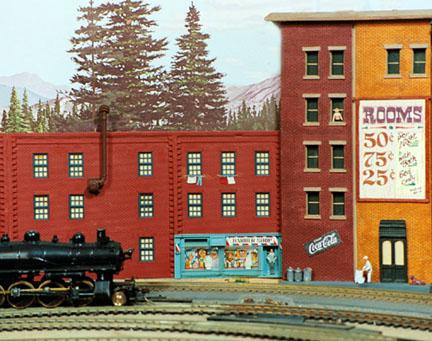
|
An
H&O Division 2-8-0 consolidation heads past the "low rent district"
near Rocky Ridge. It seems to be a slow morning as the lonely barber
awaits a customer with both chairs in his shop windows empty, the lady
in the right third floor window of the rooming house appears to have
forgotten some of her clothing, and a sleepy dog watches the janitor
head for the overflowing trash cans with another load of rubbish. [The
posted prices for rooms -- perhaps difficult to read -- are "50 cents
per night, 75 cents with bath, and 25c for bed only"]. A shave and a
haircut at the barber shop would be another two bits. |
|

|
An HO
two-room school house built from a Revell kit in the early 1980s
deserves a spot on this Hilton Module of the H & O Division, as the
author began his education attending a two-room schoolhouse near
Hilton for six years in the 1930s. This kit represents a conversion of
a former railroad station to serve a small town's educational needs.
On the H & O, however, the wood building pictured here is only a
representative "cousin," since Norm's real school was of brick and
masonry block construction, and was not near any railroad. |
|
| |

|
[ Home ]
|

|
|